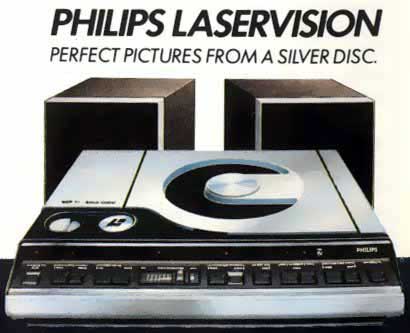 There
was a big push for Laserdisc in the early-80s, but it didn't catch on
in the UK. It was too expensive, there was too little software, people
were still getting used to video, and there were several competing standards.
It had much more success in America, as people there had lots of money
and were bored with video.
I can still remember a competition in kid's television comic Look-In
at the time to win a laserdisc player and copies of 2001: A Space
Odyssey and Close Encounters of the Third Kind: The Special Edition.
I entered, but I didn't win. How different life would have been if I
had won. I'd know those two films off by heart, for a start, as they
would probably have been the only laserdiscs we would have owned.
There
was a big push for Laserdisc in the early-80s, but it didn't catch on
in the UK. It was too expensive, there was too little software, people
were still getting used to video, and there were several competing standards.
It had much more success in America, as people there had lots of money
and were bored with video.
I can still remember a competition in kid's television comic Look-In
at the time to win a laserdisc player and copies of 2001: A Space
Odyssey and Close Encounters of the Third Kind: The Special Edition.
I entered, but I didn't win. How different life would have been if I
had won. I'd know those two films off by heart, for a start, as they
would probably have been the only laserdiscs we would have owned.
There was another big push for Laserdisc in the mid-90s, and it was
growing in popularity before being snuffed out utterly and permanently
by DVD. Nonetheless, the 1996 widescreen, THX-remastered laserdiscs
of the original Star Wars trilogy remain the best way to watch
the series at home, and will probably remain the best way to watch the
films in their pre-'Special Edition' forms. Furthermore some old laserdiscs
also have more or different extras than their equivalent DVDs - Tron
and the Criterion Collection version of Blade Runner were particularly
notable in this respect.
It's worth mentioning VideoCD, too, which hit the UK in the early 1990s.
VideoCD was a pre-DVD digital video format which used standard compact
discs to store MPEG data, one disc per hour of film. It was massive
in Japan but, as with Laserdisc, it baffled consumers in the UK. Philips'
CDi was the only readily-available VideoCD player on the market, and
an advertising push which positioned the machine as a big... multimedia...
thing... confused people into inaction. There were MPEG cards
for most of the CD-based consoles (including a special release of the
Playstation, which was bright white and rare outside Japan), and there
was a subculture of Anime fans who kept specialist importers in business
for a while. DVD also squashed VideoCD; the picture quality of VideoCD
was worse, the sound was usually plain stereo, and there were no extras
at all of any kind, rarely even chapter stops.